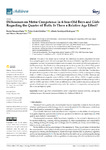Differences on Motor Competence in 4-Year-Old Boys and Girls Regarding the Quarter of Birth: Is There a Relative Age Effect?

Use this link to cite
http://hdl.handle.net/2183/27795Collections
- Investigación (FEDU) [938]
Metadata
Show full item recordTitle
Differences on Motor Competence in 4-Year-Old Boys and Girls Regarding the Quarter of Birth: Is There a Relative Age Effect?Author(s)
Date
2021Citation
Navarro-Patón, R.; Arufe-Giráldez, V.; Sanmiguel-Rodríguez, A.; Mecías-Calvo, M. Differences on Motor Competence in 4-Year-Old Boys and Girls Regarding the Quarter of Birth: Is There a Relative Age Effect? Children 2021, 8, 141. https://doi.org/10.3390/children8020141
Abstract
[Abstract] The aim of this study was to evaluate the differences on motor competence between boys and girls aged 4 years old and investigate the existence of Relative Age Effect on their motor competence. In total, 132 preschool children were evaluated, of whom 60 (45.50%) were girls and 72 (54.5%) were boys. The distribution of the participants was from quarter 1 [n = 28 (21.2%)], quarter 2 [n = 52 (39.4%)], quarter 3 [n = 24 (18.2%)], and quarter 4 [(n = 28 (21.2%)], respectively. The Movement Assessment Battery for Children-2 (MABC-2) was used to collect the data. The data show the main effects on quarter of birth factor in manual dexterity (MD; p < 0.001), in aiming and catching (A&C; p < 0.001), in balance (Bal; p < 0.001) and in total test score (TTS; p < 0.001). There are also statistical differences on gender factor in MD (p < 0.001) and in TTS (p = 0.031). A significant effect was also found in the interaction between two factors (gender and quarter of birth) in MD (p < 0.001), A&C (p < 0.001), and Bal (p < 0.001). There are differences in all the variables studied according to the quarter of birth and only in manual dexterity and in the total score if compared according to gender (the scores are higher in girls).
Keywords
Relative age effect
Schoolchildren
Motor competence
Manual dexterity
Aiming and catching
Balance
Movement Assessment Battery for Children-2 (MABC-2)
Schoolchildren
Motor competence
Manual dexterity
Aiming and catching
Balance
Movement Assessment Battery for Children-2 (MABC-2)
Editor version
Rights
Atribución 4.0 Internacional






